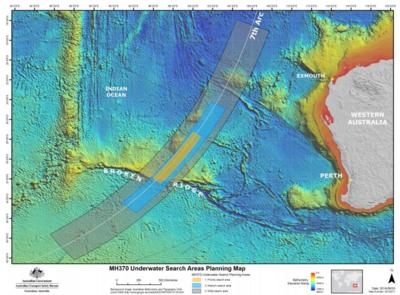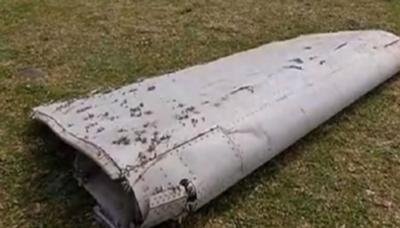Kiwi Researcher Alleges “Yes”
Forty-two minutes after midnight on 08 March 2014, a Boeing 777-200ER, registration 9M-MRO operating as Malaysia Airlines flight 370 (MH370) departed Malaysia’s Kuala Lumpur International Airport (KUL), climbing northeast-bound toward the South China Sea, beyond which lie its filed destination, China’s Beijing Capital International Airport (PEK).

The flight’s aircrew comprised Second In Command (SIC) Fariq Hamid, a 27-year-old junior aviator just one training-flight away from full SIC certification, and 53-year-old Pilot In Command (PIC) Zaharie Ahmad Shah, one of Malaysia Airlines’ most senior and respected pilots. The two men commanded a cabin-crew of ten flight attendants and held in their collective agency the lives of 227 passengers, the Chinese majority of which was salted with persons hailing from Malaysia, Indonesia, India, France, Iran, Ukraine, Canada, New Zealand, the Netherlands, Russia, Taiwan, and the United States.
MH370’s last transmission to Air Traffic Control was made 38-minutes after departure from over the vast waters of the South China Sea. At 01:19 MYT, as MH370 approached the terminus of Malaysian airspace, Malay air traffic control handed the flight off to Ho Chi Minh Center (VVHM). Zaharie transmitted, “Good night, Malaysian three-seven-zero,” but did not read back the assigned VVHM frequency.
Minutes later, MH370’s secondary (transponder) radar return vanished from ATC radar. The 777’s primary return, however, was tracked by military radar for another hour and observed to deviate west of its flight-plan route, crossing the Malay Peninsula and Andaman Sea before venturing beyond radar range some two-hundred-nautical-miles northwest of Penang Island in northwestern Peninsular Malaysia.
Notwithstanding the costliest search in the history of aviation, no further sign of the MH370, excepting bits of debris washed up on African, Micronesian, and Melanesian shores, has been spied by human eyes. The paucity of wreckage and evidence may, however, be coming to an end.

Vincent Lyne, a former researcher at the University of Tasmania’s Institute for Marine and Antarctic Studies (IMAS) who’s devoted years of his life to studying the MH370 disaster and its cryptic aftermath, alleges he’s pinpointed the location of the doomed airliner’s wreckage. Mr. Lyne asserts that what remains of the MH370 lies at the bottom of “a deep [oceanic] hole about 1,500-kilometers (810-nautical-miles) west of Perth.”
Mr. Lyne claims to have secured flight-simulation data recovered from the home computer of MH370 PIC Zaharie Ahmad Shah by official investigators of the MH370 accident. Subject data consists primarily of a simulated flight of a Boeing 777-200ER along two tracks—one northerly, the other southerly—that resemble but ultimately diverge from MH370’s filed flight-plan route. Mr. Lyne contends his hypothesis pertaining to the whereabouts of the main body of MH370’s wreckage is “the only theory that reconciles all evidence, has uncovered new satellite evidence of debris streaming out from the location, and uncovered the riddles in the simulated track.”
The debris to which Mr. Lyne referred is a Boeing 777 main-landing-gear door, known also as a trunnion door, found in the possession of Madagascan fishermen in late 2022. The artifact appears to have been penetrated by fragments of the MH370’s engines as they disintegrated—an occurrence only possible if the 777’s landing gear had been lowered prior to the jet’s impact with the oceans’ surface. Such an action directly contradicts open-water ditching protocols and substantiates a widely espoused theory that MH370 was deliberately crashed by Zaharie Ahmad Shah.
Mr. Lyne’s opinion vis-à-vis the landing-gear door is corroborated by a report jointly published by British engineer Richard Godfrey and American Blaine Gibson, a self-described MH370 wreckage hunter, who postulate: "The fact that the damage was from the interior side to the exterior side ... leads to the conclusion that the landing gear was highly extended on impact, which in turn supports the conclusion that there was an active pilot until the end of the flight.” The report continues: "The level of damage with fractures on all sides and the extreme force of the penetration right through the debris item leads to the conclusion that the end of the flight was in a high-speed dive designed to ensure the aircraft broke up into as many pieces as possible. The crash of MH370 was anything but a soft landing on the ocean.”
The report concludes in part that the combination of deliberate high-speed impact—intended to break up the aircraft—in conjunction with the extension of the 777’s landing gear—intended to sink the aircraft as quickly as possible—shows a "clear intent to hide the evidence of the crash."

The Malaysian government’s official account of the MH370 disaster states somewhat speciously that the accident aircraft turned southward once it reached the Andaman Sea, flew straight for hours until it ran out of fuel, and plunged into that part of the southern Indian Ocean by which Australia and Antarctica are separated. Whoever was flying the plane—most researchers indicate Zaharie, who possessed the requisite knowledge to execute such a maneuver—likely depressurized the 777’s cabin early on, asphyxiating everyone on board hours before MH370 plunged into the sea.
The antecedent account is cogently supported by the widely-touted argument that the Malaysian government—which is rife with corruption and not known for transparency—likely knew more about Zaharie’s personal life than it let on during the MH370 investigation. What’s more, the official Malaysian accident report, released in July 2018, offered neither definitive conclusions nor ruled out “unlawful interference by a third party.”
Three unofficial narratives have arisen from the miasmic uncertainty in which the MH370 tragedy is mired: flight-crew malfeasance and two intriguing hijacking scenarios, the first of which sets forth that Russian operatives stole MH370 via the plane’s electronics bay—accessible by a hatch in the first-class cabin—to distract global attention from the then-nascent Crimean war.
The second hijacking scenario—proposed by French journalist Florence de Changy—purports that MH370 was shot down over the South China Sea by the U.S. military for purpose of preventing mysterious cargo from reaching China. Ms. De Changy’s theory hinges on the assumption that MH370 radar returns and satellite data—as gleaned by Malay air traffic control and Inmarsat respectively, were fabricated as part of a massive-cover-up. Both the Russian and U.S. hijacking theories assume washed-up debris was either wrongly attributed or artfully planted.
 ANN's Daily Aero-Term (04.30.24): Runway Centerline Lighting
ANN's Daily Aero-Term (04.30.24): Runway Centerline Lighting ANN's Daily Aero-Linx (04.30.24)
ANN's Daily Aero-Linx (04.30.24) Airborne 04.24.24: INTEGRAL E, Elixir USA, M700 RVSM
Airborne 04.24.24: INTEGRAL E, Elixir USA, M700 RVSM Airborne 04.29.24: EAA B-25 Rides, Textron 2024, G700 Deliveries
Airborne 04.29.24: EAA B-25 Rides, Textron 2024, G700 Deliveries Airborne-NextGen 04.23.24: UAVOS UVH 170, magni650 Engine, World eVTOL Directory
Airborne-NextGen 04.23.24: UAVOS UVH 170, magni650 Engine, World eVTOL Directory





